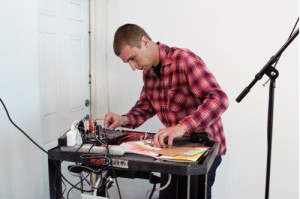About Wave Farm
From Radio Survior: Radius creates an on-air exhibition space for transmission art in Chicago
Apr 30, 2013 7:58 am
Posted in Radio Survior on April 29, 2013 by Paul Riismandel
Several times a month, mysterious and unique sounds appear on the Chicago airwaves. Listeners might hear the rumble and pop of very low frequency signals generated by environmental electromagnetic fluctuations, or collaged field recordings from distant city streets.
Some may mistake these transmissions for strange interference, or a broken radio, while others may be briefly captured by the unfamiliar modulation. They emanate on different days, at different times, originating from different geographic locations, but all existing in a certain Hertzian space.
That space is called Radius, “an experimental radio broadcast platform,” that project director Jeff Kolar describes as an exhibition space for sound artists who use the electromagnetic spectrum in their work . “Instead of an empty gallery space for a month,” he tells me, “they get the airwaves.”
Listeners might be forgiven for mistaking a Radius broadcast. As Kolar notes, “there is no spoken text. There’s an introduction for the first 14 seconds”–which to me recalls the innermost locked groove of a vinyl LP–“followed by the audio.”
I first learned about Radius via the project’s tumblr, and was immediately excited to learn that it includes a radio broadcast. Unfortunately, living on Chicago’s far north side, far away from the most densely active artists’ outposts in the city, I’ve not been able to tune in any of the broadcasts. But since this is 21st century we can all enjoy Radius’ auditory exhibitions by podcast. However, the airwaves are the first priority; all works are broadcast before being released onto the interwebs.
Jeff Kolar
Kolar agreed to meet with me for an interview and beers on a too-chilly early April evening in the Printer’s Row neighborhood. He explains that the artists choose the date, time and origination point of the broadcast, so that the broadcast schedule itself is a part of the work.
He started Radius as an outgrowth of his own sound projects and an interest in collaborating in art practice. Because there’s only a handful of people creating transmission art he wanted to create a platform that could host artists with a broadcast as well as a comprehensive online archive, what he calls “a secondary digital version.”
The idea for Radius gelled when Kolar borrowed the Audio Relay, a self-contained mobile broadcast station created by the Intermod Series. The Relay is the size of a suitcase, powered by a rechargeable battery that can replenish by solar or plain old AC. He was inspired by a traveling art exhibition called Beyond Green: Toward a Sustainable Art which toured the Relay throughout the US and Europe.
Kolar sent out the first call for entries on sites frequented by like-minded artists, such as Rhizome and free103point9, and it quickly snowballed. He works directly with each artist to curate the broadcast. Radius’ editor, Meredith Kooi, assists each artist in refining a written statement, which Kolar says “gives strength to what is broadcast.”
Radius first opened its Hertzian gallery in January 2011. 38 episodes have transmitted the work of more than 60 artists, since. Radius is also heard on two broadcast stations, WGXC-FM in New York’s Hudson Valley and Guadalajara’sSociacusia FM, and Chicago online station NUMBERS.FM.
Two years later Radius has received enough submissions to have the entirety of 2013 booked, which allows Kolar to curate a whole year at a time. “The project has an arc,” he explains, with each episode a coordinate on that curvature.
The project now has a global following, which Kolar says he never saw coming. “It’s out of left field.” He finds it particularly interesting that so many artists are want to be broadcast on a small 4-watt transmitter in Chicago. In fact, all but 3 artists broadcast so far have been from elsewhere.
Although Radius can be seen to fit the familiar mold of the podcast, Kolar says it also is a kind of net-based record label, since it does release each episode as a Creative Commons free download. “Sharing is a way to produce culture,” he tells me, “everything is already remixed.” He believes artists should be given proper attribution for their work, but that “from an ethical standpoint sharing will make the world a better place.”
On whether the online instantiation of Radius is a podcast, a label or something else, Kolar prefers “to keep that ambiguity. The idea is to navigate different scenes.”
Meeting on a weeknight with an early day of work ahead for both of us meant we had to cut our conversation shorter than the flow of our discussion would otherwise permit. Lucky for me, Kolar has promised to invite me to his studio space and let me see the Audio Relay in real life.
Kolar and Kooi will be presenting at the Trans X Transmission Art Symposium, May 17 – 20, which is part of the Deep Wireless Festival of Radio and Transmission Art in Toronto. They will be giving a paper on a series they did in January through March of 2012, in which they commissioned three art groups to create works on transmission space, distance and range.



